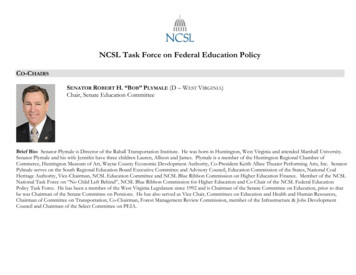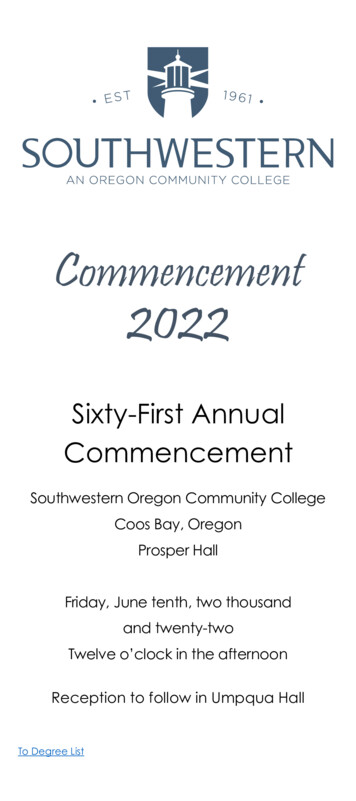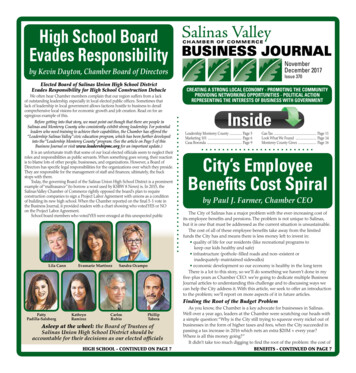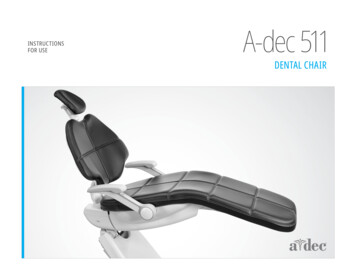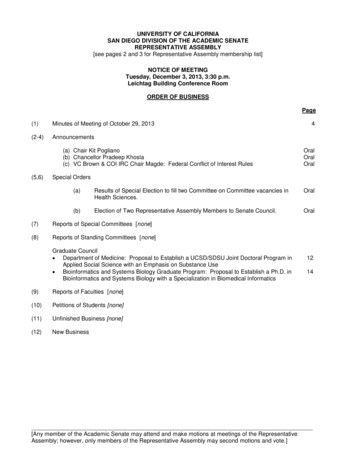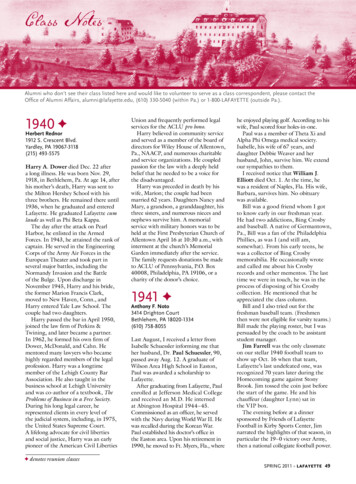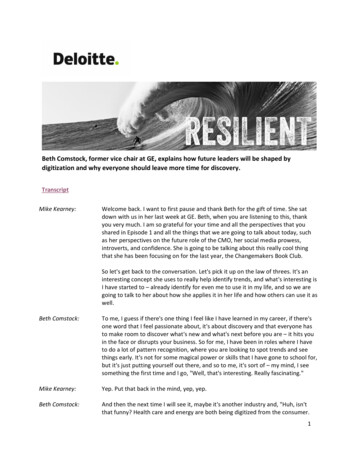
Transcription
Beth Comstock, former vice chair at GE, explains how future leaders will be shaped bydigitization and why everyone should leave more time for discovery.TranscriptMike Kearney:Welcome back. I want to first pause and thank Beth for the gift of time. She satdown with us in her last week at GE. Beth, when you are listening to this, thankyou very much. I am so grateful for your time and all the perspectives that youshared in Episode 1 and all the things that we are going to talk about today, suchas her perspectives on the future role of the CMO, her social media prowess,introverts, and confidence. She is going to be talking about this really cool thingthat she has been focusing on for the last year, the Changemakers Book Club.So let's get back to the conversation. Let's pick it up on the law of threes. It's aninteresting concept she uses to really help identify trends, and what's interesting isI have started to – already identify for even me to use it in my life, and so we aregoing to talk to her about how she applies it in her life and how others can use it aswell.Beth Comstock:To me, I guess if there's one thing I feel like I have learned in my career, if there'sone word that I feel passionate about, it's about discovery and that everyone hasto make room to discover what's new and what's next before you are – it hits youin the face or disrupts your business. So for me, I have been in roles where I haveto do a lot of pattern recognition, where you are looking to spot trends and seethings early. It's not for some magical power or skills that I have gone to school for,but it's just putting yourself out there, and so to me, it's sort of – my mind, I seesomething the first time and I go, "Well, that's interesting. Really fascinating."Mike Kearney:Yep. Put that back in the mind, yep, yep.Beth Comstock:And then the next time I will see it, maybe it's another industry and, "Huh, isn'tthat funny? Health care and energy are both being digitized from the consumer.1
Wow." Third time, "Okay, this is a trend. This is really – you can draw a linethrough it." You know, it's pretty simple. It's a simple mind – it's a simpleframework for my head.Mike Kearney:Yeah.Beth Comstock:And then I go back and I go, "I am seeing this. I think there's something here.There's a hypothesis. This is going to impact us across industries. Let's look into it."For us, Ecomagination a decade ago was that. We were starting to see more andmore industries look for cleaner tech solutions. It wasn't just in the energy space.So I think companies need people who do that, but I think everybody needs a littlebit of that in their business life. It's our expertise. It's just a simple little device thatjust reminds you to sort of stop and observe. That's what that one does to me, juststop, really, huh, ask questions.Mike Kearney:I am going to quote you – I think this is a quote, but you said, "Traditionalcompanies are now coming to their moment of digital reckoning," and obviously,GE has been at this for several years. I think you guys have some really interestingstories where it's almost a mashup of the industrial age with the digital age. Canyou give – when you talk about – that may mean absolutely nothing to certainpeople. Can you give an example or two of what GE has done over the last coupleof years?Beth Comstock:Yeah, well, for us, it's really been since about 2010 that we started looking at thesetrends of the digitization that – the Internet was having a big impact onconsumers. What did it mean in the industrial space? And we saw it in energy,health care, transportation. So, what does that – so we have embraced that in ahuge way, invested in our own technology, and it basically means embeddingsensors and controls into hardware so that they become intelligent, and the dataand artificial intelligence gives you insight.So to me, the simplest way to think about it is imagine if your jet engine – you areflying home – tweeted. Okay, it's not really, but it's sending out a signal. It's anupdate.Mike Kearney:It's a message, yep.Beth Comstock:And it's – someone in the service shop gets those messages like, "I am great.Everything's good." But what happened if one of them like, "No, it's getting a littlehot in here"? "I need to come in early. You were planning to service me in threeweeks? You might want to do it in three days." So I think it's that insight, and overtime, you start to get all the data and analytics that start to come out of the usecases, and people who run companies can run them better.You are able to say, "Hey, if you are flying a jet engine over the desert versus overthe North Pole, there are different factors and different ways this – based on whatwe see in other fleets, based on what we know from the material properties," allthis is – it's not science fiction anymore; it's really happening.2
Mike Kearney:It's really happening. You said something that was in a speech or an interviewwhere you had compared the social connections that have happened over the last10 or 15 years – and there are hundreds or millions or billions – and then you said,"Think about how many connections there are in machines." I forget the exactnumber it was that you threw out, but it was like, wow, never thought about it.Beth Comstock:Yeah, well, basically, if you look at what's happened to us as a society, I mean, weare living it out loud in many ways, but three-plus billion people connected to theInternet, on its way to five. Everybody is trying to get everyone connected. Nowimagine when 50 billion – with a "B" – machines get connected, and that's theestimate for 2020, and it's almost 2018. It's not that far away.Mike Kearney:I know. It's crazy.Beth Comstock:And that's what it means. I mean, so if you take industry and you start to put these– the digitization, it means your trains move faster. It means it costs a railroadoperator less money to operate a train because things get there faster in ahospital.Mike Kearney:Diagnoses are better. Yeah, it's everything, yep.Beth Comstock:You can – a radiologist can see more by comparing the chart to every other X-raythat's been done. A nurse, it takes a nurse 20 percent of their time to find thingsthat get lost in a hospital setting.Mike Kearney:That is fascinating, yeah.Beth Comstock:So now if you can –- if it has a sensor and control and even a robot with it, you cansummon it. It's those kind of things that I think are – we're going to see changeand make industry more productive. That's what we have been betting on.Mike Kearney:So, what about organizations that have been dabbling in those but haven't gottenserious or have finally woken up to the trend but really haven't thought about it –what means for them strategically? What advice would you have for them becausenow they are seven years after GE got into this? What should they be doing?Beth Comstock:Well, we have not been perfect, and I don't think anyone has been perfect at it.So we certainly haven't been perfect. The race is still on. You have got the digitalfirst companies. I think realizing it's not just about digitization. Actually, a companythat's been in running – helping run airlines for 80-plus years probably knows a lotabout running an airline that we, digital team, didn't know. So I think we are eachgoing with our expertise.So I actually think the race is on and I don't think it's too late for anybody. I don'tthink – in certain pieces of it, you know, we have got cloud development and youhave got artificial intelligence. Some of those things are – the race is way ahead. So3
I think every company is going to have this, so the faster you can just create oneparty or company that's figuring this out and then figure out how do you spread itto the rest of it. I wish we had started slightly differently or at the same time – Ithink we have come to this – you have to digitize how you work, not just the thingsyou work with, and that was a hard one – lesson.Mike Kearney:So when you say that, are you saying – and I think this is where you are going is weshould have thought internally about how we digitize, which I think that's actuallya really pragmatic thing that every leader could say, is if we're going to go downthe path of digitization – God, that was not good.Beth Comstock:I know.Mike Kearney:Digitization – let's think about our organization at the same time.Beth Comstock:Exactly. I have been working at a lot with sales and marketing, and you think,"Okay, Salesforce.com, we get all of our sales folks, we start to have a digitalpipeline, we are done." "Oh, you are just starting," and you have to digitize everypiece of your activity. Every function needs to do that. It's not a matter of justsaying, "Oh, now we have got a software system," but you have to workdifferently.So in the case of a sales person, you are getting much faster feedback loops. Youare able to say, "Hey, artificial intelligence is starting to help me think – you knowthat person I have is a warm lead? Actually, AI can now tell me that person is notan influencer at all. They have no decision-making power, and so I have spent ayear trying to win this person –Mike Kearney:Building that relationship, yep.Beth Comstock:– and they are never going to buy anything.Are you going to – " so that can free me up to get focused and more consultative,more spending time with the customers I know want to buy things, know want tosolve problems. So all of us, every function we have got, we have got to getsmarter.Mike Kearney:Yeah, I just want to pause because I think there is a really important learning, andthe reason why that resonates with me so much, I actually now lead somethingcalled our Brand and Reputation Venture Fund, and the idea was not, "Hey, here'ssome cool technology and things that we could bring out to clients." Five yearsago, we went on a journey where we said, "You know what, we are havingreputational issues that are hitting the marketplace. What could we do better tomanage this risk?" So we have invested in technology and things like that. It's somuch easier to go have a conversation with a client to say, "Hey, this is somethingthat Deloitte did because we needed to from a business perspective."Beth Comstock:Exactly.4
Mike Kearney:So it's almost the same type of thing, like if you have lived and breatheddigitization, it's much easier to robotics.Beth Comstock:Exactly, and okay, I will buy this product, but I don't know the first thing about howI – in a digitized world – take if you are an industry, right? You are an industrialcustomer right now.You have got to get your chief information officer, your chief technology officer,your supply chain, your sourcing – a number of people now have to cometogether. It's not as simple as, "Well, I can buy this machine and put it in thefactory." It's not going to work that way anymore.Mike Kearney:Right, right. So let's talk about talent because I think there is something that'sinteresting also happening, which is what does the future of work look like forpeople. So especially in a digital world, you got to hire for them, but you also needto develop, internally, what's your perspectives – not even just necessarilydigitization, but just in all the areas that you have worked in, what are you thinkingabout the worker of the future and that could go in so many different ways. Itcould go to the value of a college degree is being debated now, you know, the factthat people are going to be probably more subcontracting where you get yourtalent. Any thoughts on that? I know it's a big –Beth Comstock:I have a lot of thoughts. We could spend a whole hour just talking about this.Mike Kearney:[Laughs] We could – we will have our second – can I come back in February?Beth Comstock:Exactly. Yeah. I have been part of teams that have looked exhaustively at this, andin some ways it's very exciting to think about the future.The reality is you have to start applying some of that today. Like, how do you maketoday exciting, too? It's not, you know, "I have a bad job today so I just can't waittill the future comes."Mike Kearney:Till the future comes, right.Beth Comstock:Or it's scary. The future can also be very scary to people because a lot withrobotics and artificial intelligence – I think that's the area that fascinates me a lot. Ihave been big in my career on creativity, judgment, strategy, and I am reallyexcited that the future is calling for more of that.Mike Kearney:So you are not worried about what – the trends that are out there.Beth Comstock:I am worried in the sense do we have enough people who are going to want to –Mike Kearney:Embrace it, yeah.Beth Comstock:– and be willing and have the skill set to do that. It's about judgment. It's not about5
– it's about strategy. It's if you want a checklist of – if you want to run everythingjust by checklist, there probably ultimately will be a robot that tells you how to dothat.Mike Kearney:That will do that, yep.Beth Comstock:So, what you need are the people who know how to deal with things when thingsgo wrong or deal with the unanticipated issues that always happen.And so I worry a little bit in business that we think everything is a process, a Ganttchart, a checklist, and we are not training – hiring or training for resilience, forjudgment, for critical thinking. So that's where I get really passionate about that.Mike Kearney:So okay, I am a kid in college. What can they do now to start to develop thoseskills? Or is it nature versus nature? Like do you think it's stuff that could be taughtor is it just who you are?Beth Comstock:I think it's both. I mean, I think we have been encouraging our kids to take code –be coders. I think there is value in that just to understand the language of thedigital world. But don't forget about critical thinking and philosophy. I didn't takephilosophy when I was in college. I am trying to read up on it as much as I can now.Mike Kearney:Now. Right.Beth Comstock:The critical thinking, the ethics, the unintended consequences. If we are going tostart programming our machines to be smart and do things on their own, are youthinking through all the unintended consequences of some of this technology?You have to think through it. What happens if? How do we do that? So I thinkthose things are going to play a bigger role. Maybe because my daughter majoredin philosophy, I am encouraged by what I think that kind of thinking is going to playforth.I think – it's adaptability. It's the resilience that you are talking about. How do you– I don't know how we hire for it, to be honest. I mean, I think you just need to putpeople in situations and have them figure it out and see how they do it.Mike Kearney:And see how they do, right.Beth Comstock:So I guess my fantasy would be that we don't ever accept a job without some kindof test, a trial.Mike Kearney:Interesting.Beth Comstock:I would love to work for somebody for three months before I made a commitment.I would love –Mike Kearney:It goes both ways.6
Beth Comstock:I would love for the people that I hire to work together for three months so thatwe can figure out if we are able to solve the problems and have the developmentwe needed. That's not realistic, you know, but I think as we talk about gigeconomy or –Mike Kearney:Maybe in the future it is. Right.Beth Comstock:– these jobs where people are going to be certified by taking on certain tasks orchallenges and build up an expertise, that becomes more realistic.Mike Kearney:Yeah, it's funny, and when I reflect when I was getting my business degree, it wasall about, "Take the most pragmatic classes to get that job," and now, almost likeyou, when I look back I go, "Gosh, I wish I took more liberal arts-type classes"because what I find is when I am sitting down with – somebody young orold, those that can have a breadth of knowledge that could talk about those thingsare far more conversationalist and interesting than somebody that just has a skillthat they have built. I would do it all over again.Beth Comstock:Yeah, I think of myself and I – because I majored in biology and I had a – I wouldhave majored in anthropology if I could have. I guess I could have, but I loveanthropology, but it's so – has given me a framework for certainly the marketingcareer I have had and the business career. To me, it's – I go forward thinking it'sless about how cool the technology is, but how does behavior change?So I think all of those things – in some ways, biology prepared me incredibly wellfor business because it's about a system.Mike Kearney:System. Right.Beth Comstock:And only now in business are we thinking much more systemically because of thedigitization and the platform theories and all these things. It's all about the system.Mike Kearney:So I have this – I am going to kind of – it's not really changing the subject toomuch, but it's talking about the analog world. So I live in – I told you before, westarted in Walnut Creek, California. We have one of the first Amazon stores, whichI just – blows me away because last year, we shut down another big bookseller.My daughter wants a record player, like vinyl records, and I think what we arefinding – starting to see is people want physical experiences more and more. Butit's, once again, going on during this digitization that's out there. I think you evenreferenced this earlier, but how do companies then balance? Is it living in thatmiddle that you talked about before –Beth Comstock:I think it's living in that middle, and it means you are going to have to be havingone foot in each. You will have to find your way forward, what's the rightcombination.Mike Kearney:Combination.7
Beth Comstock:I mean, when you – as you said, when Amazon first announced that they werecoming out with bookstores, you are like, "Are they punking us?"Mike Kearney:"What?" Right.Beth Comstock:Right. "What?" But they realized they – people wanted to actually look at a book.They wanted an experience, and so I think it is that mash-up. I think the peoplewho can get that mash-up of the physical-digital – and it's also contextual. In ourlives, we are multidimensional people. We don't want everything to be exactly thesame all the time and we have different moods. I think there's a hugesegmentation going forward for marketers, for businesses where it's state of mind.It's contextually relevant at the moment. It's not just, "I am a woman." It's not just,"I am X age. I am an American. I am a east coaster," or, "a southerner." I thinkthose things are maybe more analog, and going forward, it's much less binary; it'smuch more fluid; we have gotten used to – culturally have much more genderfluidity. I think there is going to be much more interest and experience fluidity. It'sgoing to be challenging and exciting for certainly business and marketing people.Mike Kearney:You know what's interesting, I just love this because what I liked about theAmazon bookstore, they almost use that technology, "If you like this, then you willlike that." They actually – that's the way they have organized all their books, likethey will have kind of an iconic book to the left and then, "Here's three otherbooks you may like." So it's really interesting how they have brought that in.Beth Comstock:Meanwhile, I mean, there's a store here in New York, I am a big fan of the founderand the store is called Story. Rachel Shechtman started it, and every six weeks it'slike a magazine and a media experience and an event. Every six weeks, shechanges out and curates a new experience in retail every six weeks. So it's hard to– it's a hybrid. It's hard – is it retail? Yeah. Is it media? Yeah. Is it experiential?Yeah. She has three or four different business models. That's just one example.You are seeing more and more of those. So I think it really is this interesting mashup of things. The winners are going to figure those two, the analog and the digital,out together.Mike Kearney:How important has all of the diversity of experiences that you have had been inyour innovation journey? And we could go through the list, but it's all out there.Beth Comstock:Essential, essential.Mike Kearney:Essential.Beth Comstock:And I feel like it's important to point out that no one gave me a prescription –some of these things happened in spite of the job I had or the company I workedfor.Mike Kearney:What do you mean by that?8
Beth Comstock:Meaning I have had crazy experiences, but I put myself out there for them. I had toopen up to them. I mean, GE wanted to get into digital more. I had to go and be anearly explorer and go and meet people who normally wouldn't meet GE, wouldn'tthink GE would be interested in them, and you have to show up on just differentmaker communities where people were hacker, things that seemingly GE wouldnever be interested in, and just understand. So I think you have to put yourself outthere to explore and experience different things, and in companies, we, again,think that's a waste of time.Mike Kearney:Was that at your own volition? Were you like, "I want to engage in this so I amgoing to do it"? And what I am trying to connect it back to is the early commentthat you made about internally taking those risks, not taking no for an answer.Was it something that you said, "This is something I am interested in; I am going togo do it"?Beth Comstock:Well, it wasn't my natural inclination because I am more reserved. I – and so tokind of put myself out there was a bit of a hard thing for me to do, but my – again,I am curious. I wanted to learn. So it would just – you would start seeing trendsand go, "I want to go learn." And so that was what I mean. I mean, I – you have to– you are taking a risk of a certain sort, one, that this is valuable to my job, that Ican go meet somebody who's in a hacker space in Brooklyn and that has anythingrelevant at all to do with GE seems absurd. But you bet it does. After a while, youstart to understand that there's a whole community of people who are makingthings. They don't need to be in a big manufacturing facility.You see that the new models of manufacturing are happening, technology – so,what you start to realize is that you – there are – the pattern recognition is muchricher when you put yourself out there.Mike Kearney:But what advice – I totally get that, but what advice would you have for peoplethat may say, "That's not part of my job" because it sounds like –Beth Comstock:Well, it's not part of anyone's job.Mike Kearney:That's my point, but you would just – you would go do it because you saw –Beth Comstock:Well, because I think maybe in some ways I have made it part of my job in thesense that –Mike Kearney:Exactly.Beth Comstock:– I had the title of Chief Marketing Officer, marketing, but there was – you know,people are like, "Marketing? You do the ads." No, we don't.Mike Kearney:Right. Exactly.Beth Comstock:Yeah, we do, but that's at the end. You are underestimating what marketing cando when it takes its name seriously, which is live in the market. Go where change9
is.Mike Kearney:Right. I love that.Beth Comstock:So I choose to define marketing differently. No one gave me a book that said,"Here are the ten – " they did – "Here are the ten steps of marketing," but I saw adifferent opportunity.Mike Kearney:But I love that because what you are saying is where there are tried-and-true waysof doing things, like maybe it's the executive of the future has to live outside ofthat bubble of, "Here's the template," or, "Here's the checklist."Beth Comstock:I think the executive of the future absolutely has to do that, and I think they oughtto challenge themselves just first by saying, looking at your calendar, "How muchroom am I making for just being out in the world?"Mike Kearney:Is this your 10 percent rule that I have read about?Beth Comstock:Yeah, it is. I mean, I just –Mike Kearney:Yeah. I love this.Beth Comstock:It's my 10 percent rule, which is, "Make room for discovery." 10 percent of mytime – and I do much more personally, but in work, I have to go meet new people,find new themes, understand what's happening. You know, you just have to.Mike Kearney:How do you – so I totally agree. Probably one of my biggest challenges – I will justrelate this to me – is the demands on our time are significant. So you have to – Iam guessing part of your answer will be, you have to be extremely thoughtfulabout where you are spending your time and be proactive. Is that part of yourroutine?Beth Comstock:I think that's exactly it. You also can't expect a direct return – an immediate return.So you meet somebody, you go to an event, you go explore something, and it maynot immediately pay off, but undoubtedly, it leads to something else that leads tosomething else.So again, you have to have a different expectation. "I am going to go here to learn.I am going to go here to experience something new and ask myself, 'What happensif this enters my world?' The digitization – again, if I looked at NBC where we weredigitizing media and the ability to say, "This is coming to industry," wasn'tapparent. But you started to see, "Hey, people are wearing Fitbits. They arestarting to look at their personal health data. Wow, this is actually – theconsumerization of health care is actually going to impact how we do health carein our customers in hospitals." So you have to be out there to see that.Mike Kearney:Is it implicit in that, though also the ability to learn how to say no, which is one ofthe hardest things – because if you are going to allocate time, that's really an10
investment for the future that you don't even know if it's going to pay off. Youneed to start to learn how to do things that maybe others are asking you to dothat, quite frankly –Beth Comstock:I am not as good at that. So it is – yes, that is what I –Mike Kearney:[Laughs] So I am not going to get any good advice on that one?Beth Comstock:That is what I aspire to, but less what I do, but I do think you have to bedisciplined. I think that you have to have a sort of – part of your time that's openfor whatever happens and then a part that's very focused and you know what yourpriorities are, and I have had to work at that second part.Mike Kearney:I just was – I am reading this book that I referenced earlier. I won't call it out rightnow, but there was this guidance where somebody said, "Rate your interest levelfrom one to ten, but you cannot answer it seven." And if you think about it, if youtake the seven out – because eight, nine, or ten is like, "I really want to do that." Ifit gets to six it's like, "Eh. It's not important." So I am going to start – I have alwaysused either –Beth Comstock:That's a good one.Mike Kearney:– "Hell yes or hell no," because if you are not, that's a great way of doing it. But it'snot an easy thing to do.Beth Comstock:Yeah. I mean, I feel in business, we think that – "We just surely need to have onemore meeting to go through those financials one more time."Mike Kearney:Oh my goodness, yeah.Beth Comstock:And there are times when you need to do that, but how often do we go, "Let's goexplore"? "I have a hypothesis. Let's go see if it's true. Let's go ask people. Let's gojust hang out and watch our customers."Mike Kearney:Right.Beth Comstock:Instead of, "Let's go try to sell them something. Let's just – let's show up with aPowerPoint pitch and 15 minutes later, we will say, 'How are you?'" So I think thatis a shift that's happening in companies, and again, a company like Deloitte, youguys – that's what you do. I think more of us are starting to come to that moreconsultative relationship, and that comes through discovery. It's hanging out withyour customers.Mike Kearney:You know, one of the things that I am actually leading to is how do you disruptthat conversation with the client where you are bringing them a new idea, and oneof the things I think we have been guilty – I think a lot of people are guilty. It's like,"Hey, customer, I have got a point of view, but damn, I am going to get throughthis." I think it's more of kind of a journey that you need to go on because you may11
have some perspectives or ideas, but they may not necessarily conform to whatyour client is doing or thinking. So anyways, we are trying to disrupt that meetingthat we have.Beth Comstock:Yeah. Good luck. I think we all need that, so it will be a good thing to pass on.Mike Kearney:Well, I will let you know how it goes. We are –Beth Comstock:I think we are all – we have been there. You sit in that meeting and it's like youlook at your watch and it's 55 minutes, and –Mike Kearney:You are like –Beth Comstock:– I have been with sales teams I am part of and we go, "Okay, but we really camehere to hear from you. We have got five minutes left."Mike Kearney:"We have got five minutes left." [Laughs]Beth Comstock:"What are your pressing needs?" Or a vendor or a potential supplier comes to youand you are like, "You didn't ask me one thing about my problem. You missed thishuge opportunity. You had an hour with me. You didn't ask me." And to me, thebest partners, the best suppliers are the ones that get to know us better than weknow ourselves. It's that trust.Mike Kearney:I agree. Well, I think it goes back to that people like to be perfect. Like, they wantto show that they know everything. So you talked about – I love – one of thethings – you have given me a lot of good nuggets today, but the whole, "We needto live in the market," that's what a CMR marketing does. What do you think therole of the CMO is in the future?Beth Comstock:I think it's much more about the customer experience, the customer journey. Ithink it's sales and marketing together. That's dog and cats, often, in any company.Because it used to be, sales had the customer relationship and maybe marketingsold it – told it – helped them target those customers. Now, it's much moretogether. It's really – marketing, I think, is much more trying to ongoing listen, helpbring the changes that are happening in the marketplace back to
an influencer at all. They have no decision-making power, and so I have spent a year trying to win this person - Mike Kearney: Building that relationship, yep. Beth Comstock: - and they are never going to buy anything. Are you going to - " so that can free me up to get focused and more consultative,
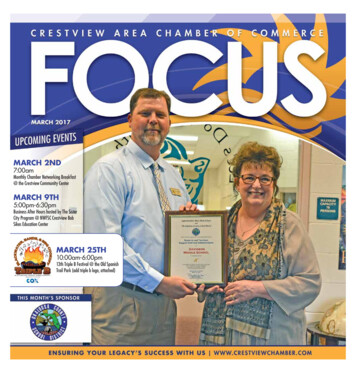
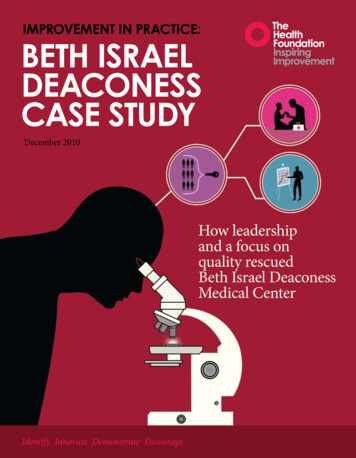
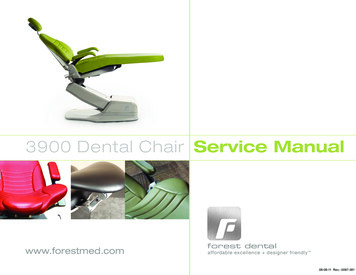
![WELCOME [ montclair.edu]](/img/31/commencement-program-2022.jpg)
